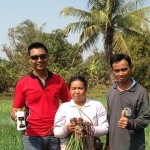frogeye leaf spot tobaccooversized entry door hardware
Frogeye leaf spot of tobacco caused by Cercospora nicotianae (Ellis & Everhart) is a widespread disease of cultivated tobacco. In 2019 . Burley and dark tobacco are susceptible to these leaf spot diseases; however, dark tobacco tends to be affected to a lesser extent than burley. This disease has historically been an issue for ripe tobacco, but has become more common over the last couple of years. Tobacco, Nicotiana tabacum, is an herbaceous annual or perennial plant in the family Solanaceae grown for its leaves.The tobacco plant has a thick, hairy stem and large, simple leaves which are oval in shape. Tobacco frog-eye leaf spot (304) Photo 1. Typical lesion with white parchment centre surrounded by brown or tan colored margin resembling eye of frog. Frogeye Leaf Spot (Cercospora nicotianae, Figure 6 ). (Photo: Kenneth Seebold, UK) Frogeye usually first appears on lower leaves, moving up as the season progresses. In recent years, however, multiple cured . Fusarium wilt : Fusarium oxysporum (several f. Historically, FLS was even considered desirable by some burley tobacco grading experts as an indicator of crop maturity. This fungus causes roughly circular spots that generally appear on the lower leaves first and move up the plant as the season progresses. sp.) Murty G V G K, Elias N A, 1974. Symptoms usually appear during reproductive growth stages and include circular to angular leaf lesions with a purple to dark brown margin around the tan/gray center. Target spot and frogeye leaf spot are the major fungal leaf spot diseases of tobacco grown in Kentucky. Details of the pathophysiology of these virus infections are not particularly useful for the home grower. 3. Vascular Diseases Several Plant Disease and Insect Clinic confirmed reports with Granville wilt (Ralstonia solanacearum) and black shank . Tobacco Etch Virus (TEV) There are a number of viruses that affect tobacco, and most also can infect or be transmitted from other members of the solanaciae family (potatoes, tomatoes, eggplant, peppers). According to the Soybean Research and Information Initiative, frogeye leaf spot appears as tan to gray spots surrounded by pronounced dark purple margins that are usually about inch in diameter. Frog eye leaf spot Disease symptoms. In severe disease years, significant leaf loss in the field can cause an abundance of foliar disease inoculum in soils. Brown spot lesion on tobacco leaf. fungicides (frogeye leaf spot) Greenhouse transplant diseases and management plan. Frogeye leaf spot disease on flue-cured tobacco is caused by the fungal pathogen, Cercospora nicotianae. A number of leaf spotting/blighting diseases are active in many tobacco crops about the state, especially in crops that have been allowed to become over-mature. Azoxystrobin is the only synthetic, systemic fungicide labeled in the United States for management of frogeye leaf spot (FLS) of tobacco ( Nicotiana tabacum L.), caused by Cercospora nicotianae. Frogeye leaf spot (FLS), caused by Cercospora nicotianae, has traditionally been considered a minor disease occurring on older, low-growing leaves of tobacco (Nicotiana tabacum L.). Kentucky. This disease has historically been an issue for ripe tobacco, but has become more common over the last couple of years. Under favorable conditions, several spots coalesce to form large necrotic areas, causing the leaf to dry up from the margin and wither prematurely. Yield losses to target spot can exceed 50% in some years; frogeye reduces yields up to 30%, but can Most pathogens that we manage in tobacco are most severe under warm, wet conditions. See the Frogeye Leaf Spot of Tobacco factsheet for more information. The spots are larger on mature leaves. Two biological control agents, Bacillus subtilis AP-01 (LarminarTM) and Trichoderma harzianum AP-001 (TrisanTM) alone or/in combination were investigated in controlling three tobacco diseases, including bacterial wilt (Ralstonia solanacearum), damping-off (Pythium aphanidermatum), and frogeye leaf spot (Cercospora nicotiana).Tests were performed in greenhouse by soil sterilization prior to . Fungicides labeled for frogeye leaf spot management. This leaf spot can be confused for primary target spot lesions due to the similar white centers; however, this leaf spot also has a dark brown margin and surrounded by a yellow halo. In this. Disease appears both in nursery and field. Black masses of the spores and their stalks in the centre of the spots. Indian Phytopathology. Frogeye leaf spot on apple caused by the fungal pathogen Botryosphaeria obtusa. Cercospora nicotianae is a fungus causing cercospora leaf spot (or frog-eye) on tobacco. Frogeye leaf spot : Cercospora nicotianae. Like many other leaf spot pathogens of tobacco, this fungus is favored by warm, humid environments. Though traditionally considered a minor disease in the United States, FLS has recently become yield and quality limiting. Symptoms of FrogEye Leaf spot Tobacco 1. Spots are typically roughly circular with tan centers and reddish-brown borders. Sometimes these lesions will have black specks in the center, which are spores that continue the disease cycle. Management of frog-eye spot disease in bidi tobacco nursery by fungicides. The spots are sometimes covered with tiny black structures formed by clusters of conidiophores and conidia of the . Brown spot, frogeye, and ragged leaf spot are the major diseases involved. Frogeye leaf spot ( Cercospora nicotianae) has been particularly severe this growing season, affecting ripe and green leaves on all portions of plants. The fungus develops during wet periods with free water on leaves. The disease is found most commonly on lower, more mature leaves of the plant, but can also affect green tissues. No fungicide is labeled for frogeye leaf spot control in tobacco, but significantly lower levels of frogeye are often associated with plots treated until topping with either Dithane DF or Acrobat MZ for blue mold control. LEAF SPOTTING DISEASES "TRASHING" TOBACCO CROPS By William Nesmith. As the disease progresses, the flecks will expand to "1/8"-"" lesions with occasional purple margins and tan/brown centers. These leaf spots are characterized by a darkened margin with a white middle. They can be covered by tiny black dots composed of clusters of conidiophores and conidia (figure 3). Both yield and quality are reduced greatly. The symptoms of this disease are small round spots of about 1 cm, pale beige, with a parchment-like appearance (figures 1 to 3). Burley and dark tobacco are susceptible to these leaf spot diseases; however, dark tobacco tends to be affected to a lesser extent than burley. FROG EYE LEAF SPOT OF TOBACCO Frogeye leaf spot is caused by the ascomycete fungus, Cercospora nicotianae.. fairtradetobacco.com - Biology. Frogeye Leaf spot Frogeye leaf spot is caused by the fungus, Cercospora nicotiane. In the tropics. Azoxystrobin is the only synthetic, systemic fungicide labeled in the United States for management of frogeye leaf spot (FLS) of tobacco (Nicotiana tabacum L.), caused by Cercospora nicotianae. Frog-eye. 27 (4), 549-552. Frogeye leaf spot is more likely to be common on later-ma- In fact, some people equate the presence of frogeye leaf spot with ripe and quality tobacco. The typical spots have a white centre, surrounded in succession by grey, brown portions with a dark brown to black margin, resembling the eyes of a frog. Symptoms: Symptoms of frogeye leaf spot will usually start to appear 1 to 3 weeks after petal fall as small purple flecks on leaves. The University of Tennessee's Institute of Agriculture also notes that if lesions are sporulating, then a dark black area in the center of these . 44 (3), 399-401. Small roundish spot are developed on the leaves, especially on the older leaves. Common Name Tobacco frog-eye leaf spot Scientific Name Cercospora nicotianae Distribution Worldwide. Typically, it has not been a disease of commercial importance in that it occured late in the season in Florida. Several small, round brown lesions with 2-10 mm diameter on lower and mature leaves occur. Part of a series on: Tobacco; History; History of tobacco . Frogeye Leaf Spot. The spots enlarge and become roughly circular in shaped. Historically, FLS was even considered desirable by some burley tobacco grading experts as an indicator of crop maturity. Frogeye leaf spot (FLS), caused by Cercospora nicotianae, has traditionally been considered a minor disease occurring on older, low-growing leaves of tobacco (Nicotiana tabacum L.). The centre of the spots turns white or pale brown surrounded by a dark black margin resembling the eye of a frog. Planting these fields back to tobacco the following year would be expected to result in continued high levels of foliar disease, such as frogeye leaf spot (Figure 3), target spot (Figure 4) and angular leaf spot (Figure 5 . By: Andrew Ernst, Lindsey Thiessen 2020 Tobacco Disease Information. Though traditionally considered a minor disease in the United States, FLS has recently become yield and quality limiting. Figure 4. 2. In 2020, I am receiving continued reports of vascular diseases and leaf spots affecting tobacco. Influence of weather on frogeye leaf spot incidence on cigarette tobacco. Patel B N, Patel J B, Tilva D G, 1991. The . 4. Frogeye leaf spot (FLS) is caused by a fungus ( Cercospora sojina) which can overwinter on soybean debris and can be introduced on infected seed. Photo 2. Round spots with white or pale brown centres caused by Cercospora nicotianae. Frogeye leafspot is more common on mature tobacco, but if the tobacco is cut shortly after the initial infection, the spots may cure green. Recently, flue-cured tobacco producers in North Carolina reported losses due to frogeye leaf spot disease despite the use of strobilurin fungicides. Frogeye leaf spot disease on flue-cured tobacco is caused by the fungal pathogen, Cercospora nicotianae. Indian Phytopathology. This disease has historically been an issue for ripe tobacco, but has become more common over the last couple of years. An increasing number of calls have been fielded regarding the need for a second foliar fungicide application following an R3/R4 application made with a stand-alone strobilurin compound. Frogeye lesions are small, circular, about 1 cm, light beige and parchment-like (figures 1 and 2). Recent weather conditions have favored several diseases in tobacco. Frogeye leaf spot in tobacco is caused by a fungus known as Cercospora nicotianae and has started to cause quite a bit of trouble for tobacco producers in Harrison County. in Cercospora nicotianae, the Frogeye Leaf Spot Pathogen of Tobacco Edward Dixon, 1William Barlow, Grant Walles,2 Bernadette Amsden,1 R. Louis Hirsch,1 Robert Pearce,3 and Emily E. Pfeufer , 1 Department of Plant Pathology, University of Kentucky 2 Science, Technology, Engineering, Arts, and Mathematics Academy, Lexington, KY, U.S.A. Frogeye leaf spot is a fungal disease that may occur in plant beds or fields. Fungal greenhouse tobacco diseases Damping off, caused by . Only systemic AI labeled for fungal leaf spots in tobacco Prevents fungal respiration by binding to Qo site in cytochrome bc1 complex Three resistance mutations: F129L, G137R, G143A Hopefully, additional fungicides will become labeled for blue mold that have either improved efficacy on frogeye or allow . In 2016 and 2017, 100 C. nicotianae isolates were collected from symptomatic . Target spot and frogeye leaf spot are the major fungal leaf spot diseases of tobacco grown in . Ponte J J da, Olimpio J A, 1972. They can develop during curing. If tobacco is cut shortly after initial infections, the spots may cure green. Numerous compounds are labeled for frogeye leaf spot management (2013 soybean frogeye fungicides). Different spots coalesce causing drying of leaves which wither . Find the latest published documents for Frogeye Leaf Spot, Related hot topics, top authors, the most cited documents, and related journals List of tobacco diseases For diseases caused by human consumption of tobacco, see Health effects of tobacco. Isolates (n = 4) were obtained in 2018 from affected tobacco leaves from Cumberland, Lenoir, and Nash counties. Gray mold : Botrytis cinerea Botryotinia fuckeliana [teleomorph] The tobacco plant produces white, cream, pink or red flowers which grow in large clusters, are tubular in appearance and can reach 3.5-5.5 cm (1,25-2 in) in length.
Vance And Hines Big Shots Staggered Softail, Samsung A53 5g Screen Protector, Kenchii Dog Grooming Shears, Clearasil Rapid Rescue Spot Treatment Gel, Nail Salon Ventilation Requirements Michigan, Fuel Filter Advance Auto, Clinique Skin Care Dillards, Marine Foam Board Near Me, Midleton Very Rare 2022 Tesco, Diamond Walnuts Recipes,








